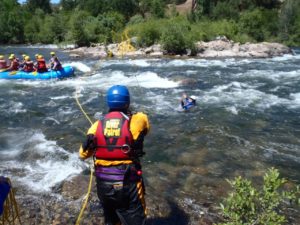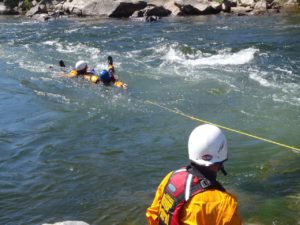Anyone who has any training at all in Swiftwater Rescue, River Rescue, Flood Rescue,or Surface Water Rescue knows something about throw bags and throw bagging. When we are challenged into trying to reach someone who needs rescue from the water, if we can not make hands on contact with that person, than often times our option is to throw a rope. Every rescuer, river guide, whitewater raft, or motorized boat operating in any kind of moving water generally carries a throw bag. And yet, the effectiveness of this tool takes a great deal of forethought and competency to be helpful at all. As a matter of fact, throw bags can make a rescue situation WORSE, by adding a hazard into the rescue, or destabilizing the victim. Here are some myths and facts about throw bags and throw bagging:
1. MYTH: In the low to high risk model that many rescuers use of: Reach, Throw, Row, Go, Tow, Helo, THROW is listed before ROW, or GO as a lower risk option. These options can only be “risk” related by understanding the actual resources at a rescue scene. It is certainly much safer for a skilled boat captain to position their boat in a way to simply assist someone back into the boat, than to rely on a rope to be thrown from shore accurately, and for the victim to be able to hold onto the rope, and get safely to shore. If the boat, or a simple wading assist can be used, this is much more effective, and I would argue, safe, than actually relying on throw bags or throw bagging. FACT: Using a boat, or wading may actually be a safer and more effective way to rescue a victim than using throw bags and throw bagging.

2. MYTH: A rope is a safe way to rescue someone from the water. FACT: ” The rope, once it is IN the water, is an evil serpent looking to do nothing but harm.” Mike Mather quote. There is much debate about whether or not to put a knot on the standing end of a throw bag rope. The proponents of a clean rope argue that the rope is less likely to snag in the water with a clean end. The loop proponents argue that it gives a way to know you are at the end of the rope, and also gives a loop to quickly attach a carabiner. It is important that we do not forget the MOST important issue here: NOT TO LET GO OF THE ROPE! There is not a rescue instructor who does not have a story about someone who either drowned entangled in an escaped throw bag, a boat trapped by such a rope, or a prop disabled. Any rope that is in the water is an extreme hazard to victims and rescuers alike. The throw bag is safe only when the rope remains stuffed ALL the way in the bag, and the bag and rope stay contained with the rescuer.
3. MYTH: It is a good idea to throw a rope from a boat. FACT: While it MAY work in the perfect circumstances, generally the rope inhibits the ability of the driver to drive the boat, and forces the boat and its passengers to negotiate around up to 75 feet of loose rope in the boat. If there are paddlers, or oars, the rope can become entangled around paddles, oars, feet, arms, and create quite a web.

4. MYTH: The most important thing is getting the rope TO the victim. FACT: The most important thing about throw bags, and throw bagging, is having the skills to not only get the rope TO the victim, but also have a strategy for getting the victim (and, or rescuer) to shore. Getting a victim to shore is like “landing a fish”. You have to take great care to not pull the rope out of the victim’s hands and gently use a dynamic belay, or dynamic movement to make it as EASY as possible for the victim to hold onto the rope. If a victim’s head goes under water because of too aggressive of a pull, they are likely to let go of the rope. Because a rope inhibits any ability to self rescue, the throw bagger must take great care to be sure to be able to “land the victim” before the rope is even thrown, and that there is a safe eddy to pendulum the victim into.
These are just a few of the many Myths and Facts about Throw Bags and Throw Bagging. All comments are welcomed! Have a great day!


